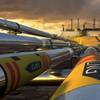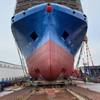The U.S. Coast Guard is working with the National Oceanic and Atmospheric Administration (NOAA) Ship Rude and will use Side Scan Sonar technology to check the condition of the T/V Bow Mariner that exploded and sank Saturday night.
The 90-foot Norfolk, Va., based NOAA Ship Rude is equipped with side scan sonar technology and will sweep the area where the T/V Bow Mariner sank to acquire imagery of the condition of the vessel. This is not the first time the Rude has been used for missions like this. Previously, the RUDE assisted with the search and recovery of TWA flight 800 in 1996 and the search and recovery operations of John F. Kennedy Jr’s aircraft and Egypt Air flight 990 off the Massachusetts coast in 1999.
The vessel T/V Bow Mariner, a Singapore-flagged chemical tanker, left Linden, N.J., for Texas City, Texas, carrying a partial cargo of 3.2 million gallons of industrial grade ethanol.
West winds in the area are carrying spilled fuel oil further out to sea and the U.S. Weather Service predicts those winds will continue for the next three days. The cargo of ethanol spilled into the water has dissipated and is not recoverable. Additional amounts of ethanol may still be in cargo tanks on the sunken ship. Portions of the fuel oil have clumped together into tar balls and mats floating on or just below the surface in quantities too small to recover. The clumped oil is breaking apart into smaller non-recoverable pieces with the wave and wind action.
The Marine Spill Response Corporation (MSRC) oil recovery vessel Virginia Responder remains on scene in the event that oil conditions change and oil recovery becomes necessary.
Clean Harbors has been contracted to recover floating debris in the area of the sinking that may pose a hazard to navigation.
The environmental impact and possible salvage operations are being managed from the U.S. Coast Guard Marine Safety Office in Norfolk, Va., by an inter-agency Unified Command which includes the Coast Guard Captain of the Port, National Oceanic and Atmospheric Administration, Virginia Dept. of Environmental Quality, Maryland Dept. of Environment, and representatives from the vessel owners and managers.
Over flights of the area with contracted aircraft will continue to monitor the progress of the oil sheen and locations of pooled oil.
Subscribe for
Maritime Reporter E-News
Maritime Reporter E-News is the maritime industry's largest circulation and most authoritative ENews Service, delivered to your Email five times per week










